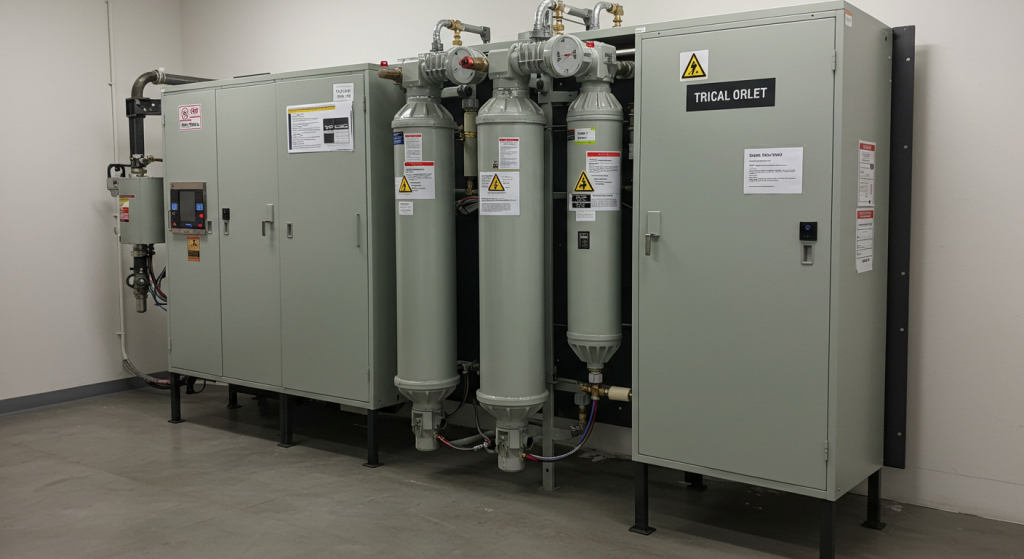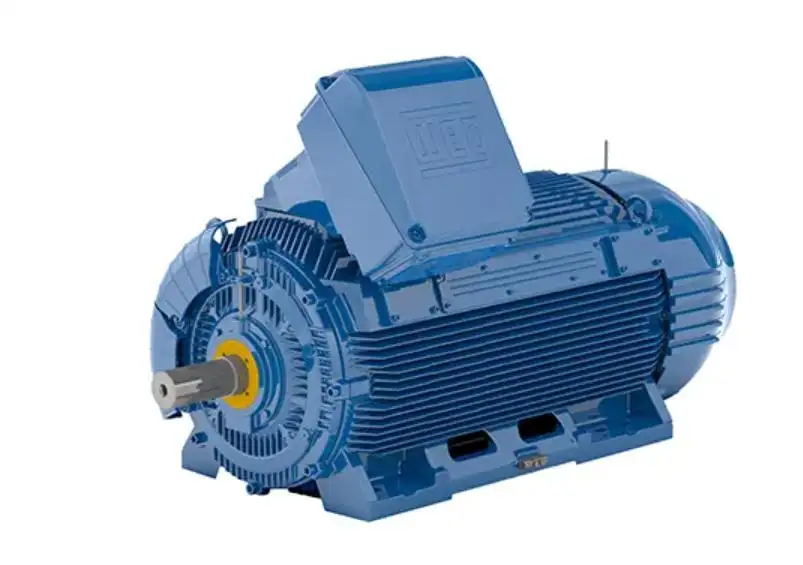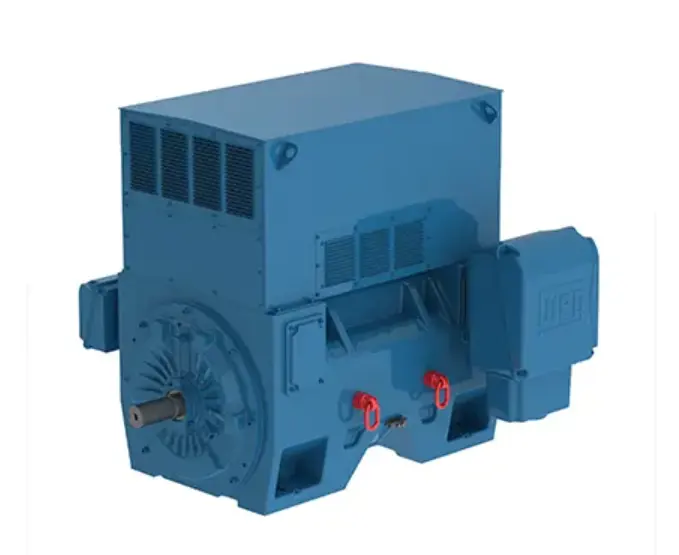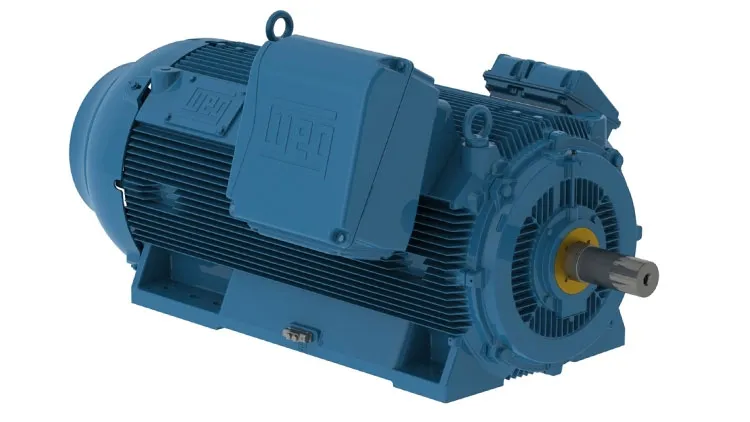Definition of Compressed Air Dryer
What is the compressed air dryer? A comprehensive overview: A compressed-air dryer is a compact filtration unit that removes water vapor from pressurized air before it reaches tools and machines. By producing dry, clean air, the dryer boosts performance, reduces wear, and lowers costly downtime. When the air gets compressed, its temperature rises, and moisture stays suspended. Cool, that air and excess vapor turn into liquid water. If these droplets are left in the flow, they can damage valves, clog filters, and lead to unexpected repair bills. A dryer pulls out that water, making it a vital piece of equipment in any compressed-air system.
Primary Function:
- Removes moisture from compressed air.
- Lowers the dew point.
- Guards against equipment damage.
Enhances overall air quality
Compressed Air Dryer: An Essential Guide for Modern Industry
- Compressed air drives a wide range of industrial tasks-from powering hand-held pneumatic wrenches to sealing boxes on high-speed lines. Yet incoming, untreated air holds moisture that can corrode metal parts, ruin seals, and spoil the quality of finished goods. To keep systems running smoothly and products up to standard, operators rely on compressed-air dryers.
- This overview explains what a dryer is, how it works, the main types on the market, and the role each plays in protecting capital equipment and output. It also outlines practical applications, routine maintenance pointers, and emerging drying technologies worth watching.
Why Dry Compressed Air Matters?
Air that comes straight from the compressor is hot and packed with water vapor. As it moves through the cooler pipes, that vapor condenses into liquid water. Though the change looks simple, it sets off a chain of problems:
Corrosion in Compressed-Air System: Water inside pipes, valves, and tools accelerates rust. Over time, that corrosion eats away at the system's metal, forcing early and expensive repairs.
Equipment Protection: Wet air strips away lubricants, cracks seals, and causes cylinders and motors to stick. The result is shorter tool life and more unscheduled downtime.
Compromised Product Quality: In sensitive fields such as food and drug production, electronics assembly, or paint finishing, even a tiny drop of moisture can spoil whole lots. By delivering dry air, facilities protect profits, reputations, and essential quality standards.
Ice Formation: When air systems run in frigid conditions, moisture in the compressed air freezes, turning into ice that clogs pipes and valves, and this blockage can bring a facility to a standstill. Such a failure is a worst-case outcome that every plant manager dreads.
Increased Maintenance Costs: Humid air forces equipment to work harder, which accelerates corrosion, rust, and mechanical fatigue, so crews end up repairing and replacing parts more often. By contrast, feeding tools with dry air sharply reduces those frequent upkeep bills and keeps production steady.
How Compressed Air Dryers Work
Drying compressed air begins with removing moisture through methods that vary by dryer type. The goal is to reach a lower pressure dew point (PDP), the temperature at which invisible steam turns into liquid water.
Common Moisture Removal Methods:
- Cooling: The air is chilled, and water vapor cools so much that it condenses into droplets.
- Adsorption: Desiccant beads trap water molecules as compressed air flows through.
- Membrane separation: Thin, selective membranes allow only nitrogen and water to pass while blocking larger molecules.
- Chemical reaction: In deliquescent models, special salts draw in moisture and then liquefy, draining away.

Why Invest in a Compressed Air Dryer?
Adding a dryer to your compressed air circuit is a straightforward choice backed by solid reasoning. The upside goes well beyond dryness alone; it underpins smoother operations, fewer failures, and savings that grow year after year. Preventing Corrosion in Pneumatic Systems: Removing moisture removes the main culprit behind rust, letting pipes and other costly machines last far longer. Equipment Damage Prevention from Wet Air: Clean, dry air protects sensitive valves, actuators, and fine tools from caustic water and rust dust, cutting expensive outages.
Enhancing Industrial Process Efficiency: Consistently dry air keeps pneumatic tools sharp, allows precise instruments to perform without drift, and gives spray paint or coatings a smooth, defect-free surface, raising product quality all around. Reducing Maintenance Costs for Air Compressors and Downstream Equipment: Less corrosion and wear lead to fewer repairs, cheaper spare parts, and less unplanned downtime, yielding sharp savings on dryer service and the entire compressed air system.
- Securing Product Quality and Safety: In sectors such as food, beverages, or pharmaceuticals, dry air goes beyond efficiency; it helps firms comply with strict food-grade air rules and safeguard consumers. In auto paint shops, moisture-free air stops fish eyes and other visible defects.
- Optimizing Compressed Air Systems: By creating those ideal conditions, a good dryer extends component life and keeps the entire compressed-air network running smoothly.
- Energy Efficiency of Compressed Air Dryers: Although dryers draw power, the savings from fewer leaks caused by rust, better tool output, and less spoiled product far exceed the unit's operating bill. Picking the right size, guided by a credible chart, is vital for sensible energy use.
Choosing Your Guardian: Selecting the Right Compressed Air Dryer
Picking the best drying solution requires a thoughtful review of several key factors:
Compressed-Air Flow Rate: The amount of air your compressor delivers, measured in CFM or m³/hr, sets the minimum size your dryer must handle.
Inlet Air Temperature and Pressure: Warmer, higher-pressure air holds more water, and these factors directly shape the dryer's workload.
Ambient Temperature: For refrigerated dryers, hot shop air adds strain and reduces cooling capacity.
Energy Efficiency Requirements: Choose between cycling and non-cycling refrigerated units or blower-purge desiccant models to match your duty cycle and budget.
Upfront Cost versus Operating Cost: A low purchase price may mask high power bills, so weigh initial outlay against future energy and service expenses.
Maintenance Considerations: Some systems demand frequent desiccant changes or filter swaps, while others run longer between services.
Maintaining Your Moisture Fighter: Air-Dryer Maintenance Tips
Like any vital piece of equipment, a compressed-air dryer requires regular attention to ensure its peak performance and longevity.
Regular Filter Replacement:
Pre-filters and after-filters are critical for protecting the dryer from oil and particulates. Follow manufacturer recommendations for replacement.
Condensate Drain Checks:
Ensure automatic drains are functioning correctly and aren't clogged. This is a common troubleshooting air dryer problem.
Dew-Point Monitoring:
Check the pressure dew-point reading at regular intervals to confirm the dryer is operating within its design limits. An upward trend signals that something is drifting out of spec.
Conclusion
What is the compressed air dryer? A comprehensive overview of a compressed-air dryer is more than an accessory; it is the front line in safeguarding every pneumatic function, from small hand tools to large production machinery. The dryer keeps the airline running smoothly, safely, and at peak energy efficiency. Whether you install a refrigerated unit for general duties or a desiccant model for mission-critical tasks, you secure your investment, prolong machine life, and boost process reliability from the first shift onward. Contact us through VIBRANT.









